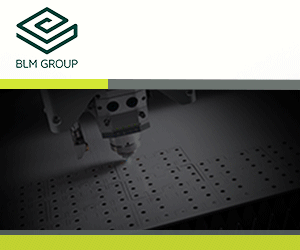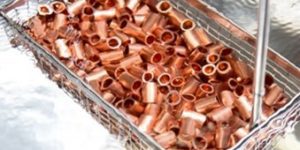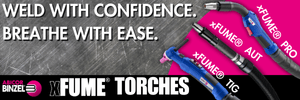HOW TO SELECT THE PROPER WATERJET FOR YOUR APPLICATIONS
Abrasive waterjet technology is evolving rapidly and the range of variables to consider may seem overwhelming. Laird Parry of OMAX provides a rational approach to follow that will optimize both waterjet selection and performance based upon your applications.
Posted: October 13, 2010
Computer-controlled Abrasive Waterjet (AWJ) cutting systems are increasingly popular with fabricating shops because of their broad range of cutting capabilities (both in material types and thicknesses), their relative precision and their ease of set-up and use.
However, this relatively new technology presents a particular challenge to shop owners and managers faced with selecting a system for purchase, and then in assuring that it is operated in the most optimum manner for their particular application. The range of variables to consider may seem overwhelming. Cutting table size and accuracy, pump type and power, nozzle size, operating pressure, abrasive flow rate, anticipated maintenance costs, water consumption rate, electrical power requirements, drain requirements, overall purchase price, special foundation requirements . . . all must be part of the buying decision.
In most cases, the decision-maker has little or no experience to rely on because this is quite possibly his first AWJ purchase. In addition, the technology is evolving very rapidly. For example, because of the flexing of the abrasive jet itself during cutting and the control techniques that are continually evolving to account for this, control software can have a major impact on part accuracy and production time. However, this impact will not be addressed on a traditional system spec sheet. For lack of better guidance, a buying decision may be made based on misguided criteria, such as lowest capital cost or fastest straight line cutting speed, and the buyer ends up with a system that might be adequate for some applications but is not well-suited to his.
There is a rational approach that an AWJ buyer can take to optimize the purchase decision based on his own particular applications. This approach is based on the idea that the buyer is best served by the machine that can produce the particular parts he needs at the level of quality he needs at the lowest possible overall cost per part. This approach takes into account all of the operating and cost variables mentioned above and helps the buyer determine which of the systems he is considering can produce the type of parts that he plans to make at the lowest unit cost.
This same approach may also be used by an existing AWJ owner to determine which combination of operating variables (pressure, nozzle size, abrasive flow rate, etc) can provide the lowest cost parts on the machine he already owns. The process is as follows:
(1) Select one or more test parts. Select a test part that is representative of the type of parts being made by the shop. This part should be representative in material type, thickness, geometric complexity and desired precision and surface finish. If the shop produces a wide range of parts, pick several that represent that range and consider them as a set.
(2) Have test parts produced. Ask the suppliers of the AWJ systems that you are evaluating to make you a sample part on the specific model of machine being considered based on the drawing of your test part. Be sure to give the supplier specifics regarding desired part accuracy and surface smoothness. The supplier should provide you with the actual test part and a summary of all of the associated operating parameters (including water pressure, nozzle size, abrasive flow rate,etc) and the actual measured production time. Ideally you should attend the making of this test part so you can get a better feel for the operation of the machine being considered and witness the actual measured production time. If you are using this approach to optimize performance of your existing AWJ machine, you will want to make several test parts with different operating parameters such as abrasive flow, water pressure and/or nozzle size.
(3) Evaluate test parts and iterate if needed. Once you have received the test parts, inspect them carefully to make sure that they meet your criteria for accuracy and smoothness. Ideally they should meet but not exceed your requirements. The idea is to have a true “apples to apples” comparison between test parts on different machines or made on the same machine with different operating parameters. If one supplier has provided you with a part that is much smoother than required, for example, but took longer to make than the others, it would be well worth his and your effort to make another sample part in which he is allowed to speed things up at the cost of some surface smoothness. Again, the goal is to end up with competing test parts that meet but do not exceed your requirements so that you can make a true comparison.
(4) Perform a financial comparison. Now that you have directly comparable test parts that meet your criteria, it is possible to perform a detailed financial comparison to determine the actual production cost for each sample. Figure 1 nearby shows a financial comparator program that is available from OMAX Corporation (click on [email protected] to receive a no-charge, no-obligation copy) or you can create your own financial spread sheet using the figure as a guide. The financial comparator takes into account all of the costs associated with making the part, including the following:
(a) Capital cost. This should include not only the purchase price of the delivered machine and accessories, but also any costs associated with installation, required utilities, special foundations (if needed), water processing equipment (if needed), etc. Financing costs should also be accounted for.
(b) Hourly machine maintenance cost. This should include not just the obvious short-term costs of nozzle orifices, mixing tubes and pump seals, but also the more subtle long-term maintenance costs such as periodic high pressure plumbing component replacement, major pump component replacement and periodic replacement of table components such as material support slats. Ideally the supplier should be able to provide estimated maintenance costs for at least a 5-year period.
(c) Costs associated with water and abrasive consumption. Remember to base water and abrasive consumption rates on the actual abrasive flow rate and nozzle orifice size used in making your test parts. Unit costs for abrasive and water (and water disposal if applicable) should be based on your local rates.
(d) Operator costs. These should be based on your own local costs.
(e) Electrical costs. Again, these should be based on your own local costs.
(f) Test part production time. This is the actual measured time it took to produce the “apples-to-apples” test part.
The results of the financial comparison provide the potential AWJ buyer or existing AWJ user with a solid rational basis for selecting a new system or operating his existing system based on what will produce the types of parts he needs at the accuracy and quality he needs at the lowest overall cost. It takes all of the variables associated with buying and operating an AWJ system and brings them down to a single figure of merit . . . cost per part . . . based on the shop’s actual application. This assures that the buyer gets the most appropriate machine for his particular application and uses that machine in the optimum way.
– – – – – – – – – – – – – – – – – – – – – – – – – – – – – – – – – – – – – – – – –
Laird Parry is a senior applications engineer at OMAX Corporation, 21409 72nd Ave South, Kent, WA 98032, www.omax.com. He can be contacted at [email protected].














